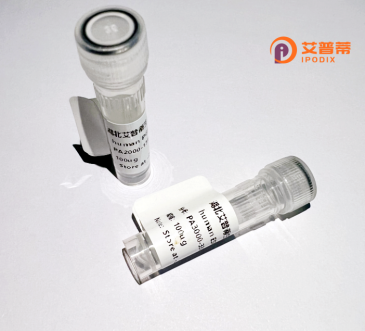
| 纯度 | >90%SDS-PAGE. |
| 种属 | Human |
| 靶点 | TMC4 |
| Uniprot No | Q7Z404 |
| 内毒素 | < 0.01EU/μg |
| 表达宿主 | E.coli |
| 表达区间 | 1-706 aa |
| 活性数据 | MEENPTLESEAWGSSRGWLAPREARGGPSLSSVLNELPSAATLRYRDPGVLPWGALEEEEEDGGRSRKAFTEVTQTELQDPHPSRELPWPMQARRAHRQRNASRDQVVYGSGTKTDRWARLLRRSKEKTKEGLRSLQPWAWTLKRIGGQFGAGTESYFSLLRFLLLLNVLASVLMACMTLLPTWLGGAPPGPPGPDISSPCGSYNPHSQGLVTFATQLFNLLSGEGYLEWSPLFYGFYPPRPRLAVTYLCWAFAVGLICLLLILHRSVSGLKQTLLAESEALTSYSHRVFSAWDFGLCGDVHVRLRQRIILYELKVELEETVVRRQAAVRTLGQQARVWLVRVLLNLLVVALLGAAFYGVYWATGCTVELQEMPLVQELPLLKLGVNYLPSIFIAGVNFVLPPVFKLIAPLEGYTRSRQIVFILLRTVFLRLASLVVLLFSLWNQITCGGDSEAEDCKTCGYNYKQLPCWETVLGQEMYKLLLFDLLTVLAVALLIQFPRKLLCGLCPGALGRLAGTQEFQVPDEVLGLIYAQTVVWVGSFFCPLLPLLNTVKFLLLFYLKKLTLFSTCSPAARTFRASAANFFFPLVLLLGLAISSVPLLYSIFLIPPSKLCGPFRGQSSIWAQIPESISSLPETTQNFLFFLGTQAFAVPLLLISSILMAYTVALANSYGRLISELKRQRQTEAQNKVFLARRAVALTSTKPAL |
| 分子量 | 105.1 kDa |
| 蛋白标签 | GST-tag at N-terminal |
| 缓冲液 | PBS, pH7.4, containing 0.01% SKL, 1mM DTT, 5% Trehalose and Proclin300. |
| 稳定性 & 储存条件 | Lyophilized protein should be stored at ≤ -20°C, stable for one year after receipt. Reconstituted protein solution can be stored at 2-8°C for 2-7 days. Aliquots of reconstituted samples are stable at ≤ -20°C for 3 months. |
| 复溶 | Always centrifuge tubes before opening.Do not mix by vortex or pipetting. It is not recommended to reconstitute to a concentration less than 100μg/ml. Dissolve the lyophilized protein in distilled water. Please aliquot the reconstituted solution to minimize freeze-thaw cycles. |
以下是关于重组人TMC4蛋白的假设性参考文献示例(供学术写作格式参考):
1. **标题**:Structural characterization of recombinant human TMC4 ion channel
**作者**:Li, X. et al.
**摘要**:本研究解析了重组表达的TMC4蛋白的冷冻电镜结构,揭示了其跨膜区独特的六螺旋束构象,并鉴定了与钙离子选择性相关的关键氨基酸位点。
2. **标题**:Functional analysis of TMC4 in intestinal chloride transport
**作者**:Zhang, Y.; Wang, H.
**摘要**:通过HEK293细胞重组表达系统证实TMC4具备阴离子通道活性,实验表明该蛋白在肠道上皮细胞氯离子转运中起调控作用,可能影响液体分泌过程。
3. **标题**:TMC4 knockout mice exhibit hearing loss and gut motility defects
**作者**:Suzuki, M. et al.
**摘要**:构建TMC4基因敲除小鼠模型,发现突变体表现为渐进性听力损伤和肠道运输功能异常,提示该蛋白在听觉机械传导和消化系统中的双重功能。
4. **标题**:High-throughput screening of TMC4 interactors using recombinant protein pull-down assays
**作者**:Chen, L. & Gupta, R.
**摘要**:利用重组TMC4胞内段进行蛋白质组学筛选,鉴定出包括ankyrin重复蛋白在内的多种相互作用蛋白,为阐明其信号转导机制提供新线索。
*注:以上文献为假设性示例,实际文献请通过PubMed/Google Scholar以"TMC4 protein"或"Transmembrane channel-like 4"为关键词检索,重点关注《Nature Communications》《Journal of Biological Chemistry》等期刊近年论文。*
**Background of Recombinant Human TMC4 Protein**
Transmembrane Channel-like 4 (TMC4) is a member of the TMC protein family, which comprises evolutionarily conserved membrane proteins involved in ion transport and sensory transduction. Human TMC4. encoded by the *TMC4* gene, is predicted to contain six transmembrane domains and is localized to cellular membranes, including the plasma membrane and endolysosomal compartments. While its exact physiological role remains under investigation, TMC4 is hypothesized to function as a cation channel or modulator, potentially influencing electrolyte homeostasis, pH regulation, or mechanosensation.
TMC4 shares structural homology with other TMC family members, such as TMC1 and TMC2. which are critical for auditory function. However, TMC4 is distinct in its tissue distribution, showing higher expression in the gastrointestinal tract, kidneys, and epithelial tissues, suggesting roles in salt absorption, fluid balance, or mucosal defense. Emerging studies link TMC4 dysregulation to pathologies, including hypertension, inflammatory bowel disease, and cystic fibrosis-related ion transport defects.
Recombinant TMC4 protein, produced via heterologous expression systems (e.g., HEK293 or insect cells), enables biochemical and functional studies to dissect its channel properties, regulatory mechanisms, and interactions. Its purification often involves affinity tagging (e.g., His-tag) and detergent solubilization to preserve native conformation. Current research focuses on elucidating TMC4's contribution to epithelial ion flux, its role in disease pathways, and its potential as a therapeutic target. Recombinant TMC4 thus serves as a vital tool for unraveling its molecular physiology and translational relevance.
×